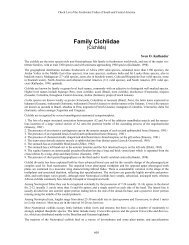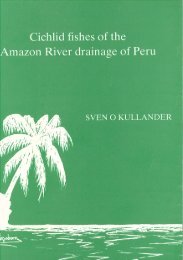Open Access PDF - Sven Kullander
Open Access PDF - Sven Kullander
Open Access PDF - Sven Kullander
Create successful ePaper yourself
Turn your PDF publications into a flip-book with our unique Google optimized e-Paper software.
Cichla nigromaculata Jardine, 1843<br />
(Figs. 21-22)<br />
Cychla nigro-maculata Jardine, 1843: 147, pl. 7 ([Rio<br />
Negro and Padauiri]).<br />
Material examined. Three specimens, 171-230 mm SL,<br />
from the upper Rio Orinoco and Rio Casiquiare, and<br />
three specimens, 98.9-263 mm SL, from the Rio Negro<br />
tentatively assigned to C. nigromaculata. Venezuela:<br />
Rio Orinoco drainage: MBUCV-V 18632, 1, 173 mm SL;<br />
Amazonas: laguna 20 m from the margin of Rio Mavaca<br />
about 2 km above the Base Camp; 29 Mar 1988, R.<br />
Royero et al. – MCNG 27874, 1, 230 mm SL; Amazonas:<br />
Mavaca, isolated laguna in old meander of Rio Mavaca,<br />
just above and to the right of the indigenous community;<br />
8 Feb 1991; L. Nico et al. Rio Casiquiare drainage:<br />
MCNG 12264, 1, 171 mm; Amazonas: Rio Siapa, about<br />
15 km upriver from the Rio Casiquiare (about 2 km<br />
upriver from Caño Chimoní); 17 Apr 1985, L. Nico et<br />
al. Brazil: Rio Negro drainage: Amazonas: MZUSP<br />
92401, 2, 254-263 mm SL; Arirará; 8 Oct 1979, M. Goulding.<br />
– MZUSP 33121, 1, 98.9 mm SL; Ilha de Tamaquaré;<br />
11 Oct 1979, M. Goulding.<br />
Diagnosis. Distinguished from all other species<br />
of Cichla except C. intermedia, C. ocellaris, C. melaniae,<br />
and C. piquiti by presence of bars 1a and 2a;<br />
similar to C. ocellaris in possession of dark blotch<br />
dorsally in bar 3. Different from C. piquiti in<br />
lower scale count (E1 row scales 75-84, vs. 83-104),<br />
and in having bars relatively narrow and short<br />
instead of uniformly wide across the side and<br />
reaching to the lower abdominal side; from<br />
C. melaniae by presence of prominent dark blotch<br />
dorsally in bar 3, and absence of numerous small<br />
light spots on side; from C. intermedia by lower<br />
315<br />
scale count (E1 row scales 75-85 vs. 96-108), absence<br />
of horizontal lateral band, and vertical bars<br />
most prominent on dorsum rather than along<br />
midaxis. Different from C. ocellaris in possession<br />
of small black spots on dorsal side, discontinuous<br />
lateral line (vs. usually continuous); more scales<br />
(E1 scales 75-84 vs. 67-82); narrower caudal peduncle<br />
(depth 10.3-11.4 % SL vs. 11.9-13.2 % SL<br />
in specimens over 100 mm SL); vertical bars 1-3<br />
wide dorsally, tapering to a point below middle<br />
of side (vs. usually relatively narrow and about<br />
equally wide from dorsum to ventral end); absence<br />
of postorbital markings (vs. presence); and<br />
presence of distinct occipital bar (vs. absent or<br />
indistinct).<br />
Description. Based on Casiquiare and Orinoco<br />
specimens. Refer to Figs. 21-22 for general shape<br />
and colour pattern, Table 14 for morphometrics,<br />
and Tables 2, 4-10 for meristics.<br />
Moderately deep (depth 28.3-31.5 % SL; N = 3,<br />
230-263 mm SL). Frontal contour about straight<br />
ascending. Maxilla reaching to below middle of<br />
orbit. Lower jaw articulation below posterior ‚<br />
of orbit. Lateral line discontinuous on both sides<br />
in all specimens.<br />
Dorsal spines 3-4 broken; soft dorsal fin<br />
rounded, not reaching to caudal-fin base. Soft<br />
anal fin rounded, reaching beyond middle of<br />
caudal peduncle. Caudal fin rounded. Pectoral<br />
fin pointed, reaching halfway to middle of caudal<br />
peduncle, or (in MBUCV-V 18632) halfway to end<br />
of anal-fin base. Pelvic fin subacuminate, first ray<br />
longest, reaching halfway to middle of anal-fin<br />
base.<br />
Table 14. Morphometry of Cichla nigromaculata. Measurements are in percent of SL, except SL (in mm). Linear<br />
regression parameters calculated from original measurements in mm.<br />
N min max mean SD a b r<br />
SL (mm) 5 171.4 262.5 217.9<br />
Head length 5 31.7 33.1 32.3 0.60 0.340 0.321 0.995<br />
Snout length 5 10.3 11.8 11.1 0.54 –4.173 0.130 0.992<br />
Head depth 5 22.3 25.2 23.7 1.05 –5.690 0.264 0.988<br />
Body depth 5 28.3 31.5 29.9 1.55 4.654 0.277 0.967<br />
Orbit diameter 5 7.9 9.3 8.6 0.60 5.042 0.062 0.953<br />
Interorbital width 5 8.0 8.5 8.3 0.17 –1.077 0.088 0.998<br />
Pectoral fin length 5 24.2 27.4 25.8 1.19 6.060 0.230 0.968<br />
Upper jaw length 5 13.9 15.8 14.7 0.74 1.653 0.140 0.977<br />
Lower jaw length 5 18.2 20.1 18.9 0.73 2.533 0.177 0.987<br />
Caudal peduncle depth 5 10.3 11.4 11.0 0.44 –1.474 0.117 0.990<br />
Caudal peduncle length 5 17.2 18.8 18.0 0.67 –0.481 0.182 0.986<br />
Dorsal spine length 5 11.8 14.7 13.2 1.08 7.146 0.098 0.934<br />
Ichthyol. Explor. Freshwaters, Vol. 17, No. 4




